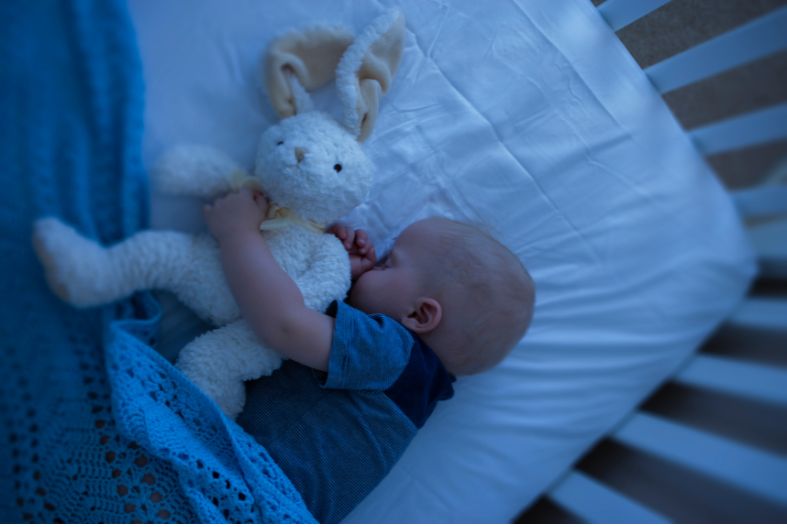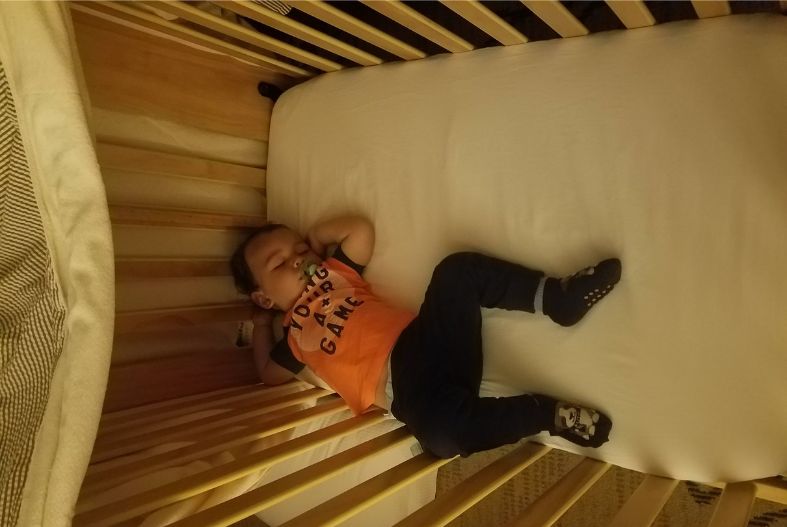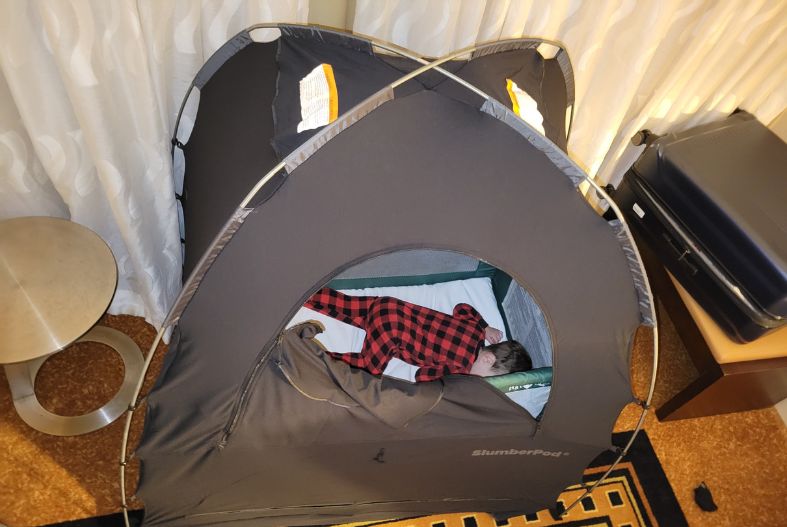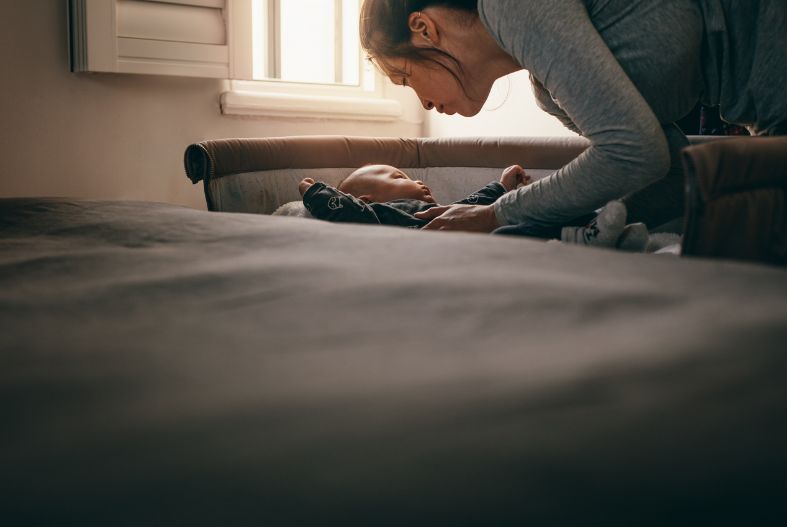This page may contain affiliate links, which means that we may earn from qualifying purchases at no additional cost to you.
One of the most challenging parts of travel with a baby is sleep! How do you get your baby to sleep well so that everyone can enjoy the trip?
In this article, we’ll share tips to set you up for sleep success when traveling with a baby.
We’ve had a lot of experience traveling with our babies over the years and sleep is typically the part that can feel the most stressful when planning a trip. You never know exactly how your baby’s sleep is going to go when you’re in a new environment.
However, while we’ve had a few disastrous sleep experiences, for the most part it usually goes much better than I anticipate, largely due to some sleep strategies that we’ve learned over the course of our travels with babies.
We’ll share those tips and tricks with you here so that you can be well on your way to a (hopefully) sleep-filled trip with your baby.
Read on for helpful baby travel sleep tips!
And be sure to check out our list of baby travel essentials!
Baby sleep travel tips
1. Make it feel like home


First off, do what you can to make your new sleep arrangements feel as close to your baby’s usual sleep environment as possible.
One of the main challenges for babies sleeping away from home is the new space feels strange and different from what they are used to, making it challenging for them to fall asleep and stay asleep.
In order to make the new sleep environment feel safe for your baby, bring a few of your baby’s sleep items from home. This could include a lovey, a pacifier, a comfort blanket, or anything else comforting and familiar.
Some people go so far as to bring the sheet that their baby sleeps on at home so that it feels and smells familiar to their baby.
2. Stick to your normal sleep routine
Another way to make a new space feel familiar is to keep your normal bedtime sleep routine from home. Follow the steps you would usually take before bed in order to trigger your baby’s body that it is time for sleep.
For example, your home routine might include changing into pajamas, reading a book, singing a song, and nursing to sleep. Try to keep that routine intact so that your baby knows what to expect, even in a new environment.
Bring a familiar book from home, use their favorite cozy jammies, sing a song your baby knows. The key is comfort and consistency.
3. Try for a private sleep space for baby


Where possible, try to have a separate sleep space for your baby. This typically makes sleep easier for both your baby and yourself while traveling.
A separate room for your baby means that it is often easier to get them to fall asleep (and stay asleep) because they aren’t distracted by having other people in the room with them. It also means that you don’t have to creep around the room trying not to wake your baby after they fall asleep.
That being said, it doesn’t always work out to have a sleep space just for baby, and that’s okay. We’ve put our babies to sleep in our same room many, many times while traveling and it tends to work out fine.
However, I would much prefer to have a separate sleep space for my baby whenever possible. It makes traveling with a baby much more enjoyable.
If you have a room with a large bathroom (and you’re okay not having access to the bathroom after baby falls asleep), you can place your baby’s crib in the bathroom to create a separate sleep space. We’ve done this several times and it works well (until you have to go to the bathroom in the middle of the night).
4. Use a SlumberPod


If you won’t have a separate room for your baby, you can create a private sleep space for them with a SlumberPod.
The SlumberPod is a portable sleep pod that goes over a crib and blocks out 100 percent of light to create a dark, cozy sleep environment for your baby.
One of the best things about a SlumberPod is that you can be in the same room with the lights on and the pod keeps the crib completely dark for your baby.
Be sure to read our full SlumberPod review to find out why this sleep device is so helpful when traveling with a baby!
The downside is that it is quite expensive, but probably not as expensive as paying for a separate room for your child. If you like the idea but not the price, you can check out this list of SlumberPod alternatives as well.
And of course, it is one more thing to pack. Buuut if it helps your baby get restful sleep, it just might be worth it.
5. Bring white noise
One thing I will never leave behind when traveling with a baby is a white noise machine. White noise is so helpful for blocking out ambient sounds that might be distracting or worrying for your baby in a new environment.
White noise also makes it easier for you to move around your room without waking up your baby after they’ve fallen asleep if you’re sharing a room. This makes it more enjoyable for you as well.
You can choose to bring a travel white noise machine or just use a white noise app on your phone. The downside to using your phone is that you aren’t able to use it for other purposes once your baby is asleep, which I find quite inconvenient.
Especially if you use white noise at home, do NOT forget to bring a white noise option when traveling.
6. Have a cozy place for baby to sleep
Another important factor is your baby’s bed while traveling. If you’re staying at a hotel, they will often have a crib available for you to use during your stay. This is also true of some Airbnb rentals. Just call ahead and check to see availability.
And also be aware that even if your hotel does have cribs available, you aren’t guaranteed that you will get one. We’ve had several instances where we have requested a crib in advance, only to find that they were all in use once we arrived.
And let me tell you, it is not fun to be stuck without a crib for your baby while traveling in an unfamiliar place. Let’s just say that none of us got much sleep those nights.
If you want to be absolutely sure you get a crib, you might need to plan on bringing one with you.
One of the best travel crib options for babies is the Guava Lotus, a compact and lightweight crib that’s fairly easy to transport.
Another option is to rent a crib when you get there using a service such as babyquip.
7. Have a nap strategy


When traveling with a baby, you’ll want to be sure to have a strategy to make sure your baby gets a good nap each day (or a couple of naps, depending on their age).
For some people, that means that you plan on being in your hotel at a certain time to put your baby down for a nap. This allows your baby to get some peaceful, uninterrupted sleep and is a good way to make sure your baby is well rested.
However, if you can get your baby to nap on the go, that’s often an even better strategy while traveling. That way you can put your baby down for a nap in the stroller or a carrier while you’re out and about, allowing you to fit more into each day.
After a little bit of trial and error, we found that our babies napped really well in a baby carrier. This was great for our trips because it meant that we could spend more time out exploring the place we were visiting as opposed to being stuck in our hotel room in the middle of the afternoon.
This will also depend on the kind of trip you’re taking. If you’re traveling for an extended period of time or visiting family, you might find that you want to have a more consistent nap routine for your baby.
8. Help your baby adjust to local time
When you’re changing time zones, it will take a little work (and patience) to get your baby adjusted to the new time.
One of the best ways to do this is to jump right into your new time zone when you arrive. Starting the first day, try to keep a local schedule as much as possible and avoid excessive naps. It can be tempting to let your baby nap all day, especially if they’re in a carrier and it allows you to explore in peace. However, know that you’ll pay for it later when your baby is wide awake at night time.
On our first big international trip with a baby I let my baby nap way too long those first few days in Italy and it led to some really miserable nights with a very alert baby. Since then I’ve learned to help my baby adjust to the new time sooner rather than later. The first few days might not be the easiest, but the rest of the trip goes much more smoothly.
Also try to spend time outside during the daytime those first couple of days, as sunlight is one of the best ways to help reset your body’s internal clock.
For more information on helping your baby adjust to a new time zone, see our article on how to fight jet lag in babies and toddlers.
9. …Or keep them on their normal schedule
The exception to this is if you’re traveling somewhere that is within a few hours time difference for a short period of time. In that situation, you might want to consider keeping your baby on the schedule of your home time zone.
In some situations, this can actually make it easier when you’re traveling. For example, if the place you’re visiting is two hours later, you can put your child to bed at the same time in your home time zone (which is two hours later local time).
This allows you to stay out later in the evening and sleep in a bit in the morning. And it makes for an easier adjustment when you return home because you don’t have to shift your child back to their normal sleep schedule.
You’ll have to decide if this strategy is right for you based on what your schedule for the trip looks like and how long you’ll be traveling.
This is also a situation where you’d really want to bring a blackout option so that you can prevent your baby’s body from adjusting to the local time based on the daylight hours.
10. Be prepared for nighttime wakeups


When you’re traveling with a baby, you’re likely to face some nighttime wakeups. Obviously this is especially true if you’re changing time zones.
While you can’t always prevent these wakeups, your approach when your child does wakeup can help dictate your baby’s sleep patterns during the rest of your trip.
If your child wakes up at night, keep the room dark and calm to let them know it is still sleep time. This will help your child adjust to their new environment and sleep schedule more quickly.
11. Maintain perspective
Probably the most important tip I could give about baby sleep during travel is to keep things in perspective.
When you’re jet lagged and up in the middle of the night with a wide awake baby, it can be easy to start regretting all your life choices. But the reality is that typically these sleep challenges are just a blip that gets resolved as your baby settles into the routine of your trip.
And even if your baby continues to struggle with sleep throughout your trip, just keep reminding yourself that soon you’ll be home and you can get your baby back on their normal sleep schedule. And get some sleep yourself!
Common questions


What should baby sleep in while traveling?
The best sleep option for travel with a baby is typically a crib or pack ‘n play. Try to see if your accommodations will have a crib available. If not, you might need to bring your own or rent.
If you’re comfortable with it, you can also choose to cosleep with your baby. In my experience, this does not provide me with the best sleep, but it might be an option for you if you already cosleep at home and you can create a safe cosleeping space to share with your baby.
Does travel affect baby sleep?
The reality is that travel is likely to affect your baby’s sleep, just like it does for adults. That doesn’t mean that this will be a huge or permanent effect, but it is true that there will likely be some impact on your child’s sleep.
There are a few factors that could mitigate this effect, like implementing some of the strategies listed in this article.
It also depends on where you are traveling. If you are going somewhere with a big time zone change, your baby’s sleep is likely to be much more impacted than if you travel somewhere with little or no time difference.
For us, we’ve found that the joy of travel outweighs any of the negative sleep issues we might have to deal with, but others might not feel the same. You’ll have to weigh the pros and cons for yourself.
How do you travel with a sleep trained baby?
You can travel with a sleep trained baby, but know that your baby might experience a sleep regression that you will need to address when you get home.
For the best chance at a successful sleep experience, try to make the space feel safe and familiar and stick to their normal sleep routine as much as possible.
It is also typically easiest to maintain sleep habits if your baby has their own space to sleep.
Final Thoughts
Figuring out sleep for your baby while traveling can seem overwhelming. However, with the right preparations you can really set yourself up for success.
We have loved traveling with our babies over the years and are so glad we didn’t avoid travel due to worries about sleep.
Other posts you might be interested in:
An Honest SlumberPod Review: The Travel Sleep Aid You Didn’t Know You Needed!
The Best Baby Toys for Airplane Travel





